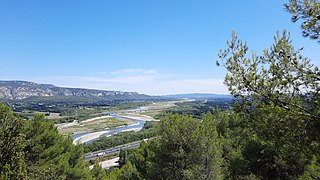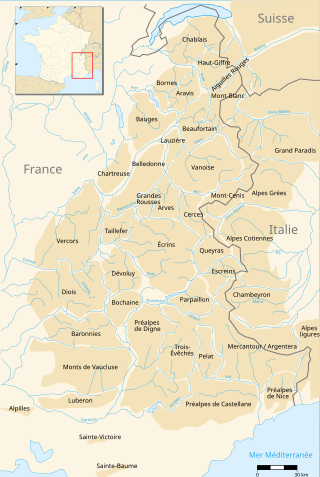
Provence is a geographical region and historical province of southeastern France, which extends from the left bank of the lower Rhône to the west to the Italian border to the east; it is bordered by the Mediterranean Sea to the south. It largely corresponds with the modern administrative region of Provence-Alpes-Côte d'Azur and includes the departments of Var, Bouches-du-Rhône, Alpes-de-Haute-Provence, as well as parts of Alpes-Maritimes and Vaucluse. The largest city of the region and its modern-day capital is Marseille.

The Luberon is a massif in central Provence in Southern France, part of the French Prealps. It has a maximum elevation of 1,256 metres (4,121 ft) and an area of about 600 square kilometres (230 sq mi). It is composed of three mountain ranges : Lesser Luberon, Greater Luberon and Eastern Luberon. The valleys north and south of them contain a number of towns and villages as well as agricultural land; the northern part is marked by the Calavon, while the southern part is characterised by the Durance.

Luberon is a French wine-growing AOC in the southeastern extreme of the Rhône wine region of France, where the wines are produced in 36 communes of the Vaucluse département. The neighbouring appellation of Ventoux AOC stretches along its northern border and is separated by the Calavon river. The southern limit of the region is marked by the Durance river.

The Durance is a major river in Southeastern France. A left tributary of the Rhône, it is 323.2 km (200.8 mi) long. Its drainage basin is 14,472 km2 (5,588 sq mi).

Manosque is the largest town and commune in the Alpes-de-Haute-Provence department in southeastern France. However, it is not the préfecture (capital) of the department, which is the smaller town of Digne-les-Bains. Manosque is located at the far eastern end of the Luberon near the Durance river.

Le Puy-Sainte-Réparade or simply Le Puy is a commune in the Bouches-du-Rhône department in the Provence-Alpes-Côte d'Azur region in Southern France. It is located on the departmental border with Vaucluse, neighbouring Aix-en-Provence to the south and Pertuis to the northeast. It is part of the Aix-Marseille-Provence Metropolis.

Gordes is a commune in the Vaucluse département in the Provence-Alpes-Côte d'Azur region in southeastern France. The residents are known as Gordiens. The nearest big city is Avignon; smaller cities nearby include Cavaillon, L'Isle-sur-la-Sorgue and Apt.

Cavaillon is a commune in the Vaucluse department in the Provence-Alpes-Côte d'Azur region of Southeastern France. It is situated in the Durance Valley, at the foot of the Luberon mountains.

Lourmarin is a commune in the Vaucluse department in the Provence-Alpes-Côte d'Azur region in southeastern France. Its inhabitants are called Lourmarinois.

The arrondissement of Apt is an arrondissement of France in the Vaucluse department in the Provence-Alpes-Côte d'Azur region. It has 57 communes. Its population is 128,793 (2016), and its area is 1,390.6 km2 (536.9 sq mi).

Cadenet is a commune in the Vaucluse department in the Provence-Alpes-Côte d'Azur region in southeastern France.

Beaumont-de-Pertuis is a commune in the Vaucluse department in the Provence-Alpes-Côte d'Azur region in southeastern France.

Goult is a commune in the Vaucluse department in the Provence-Alpes-Côte d'Azur region in Southeastern France. In 2021, it had a population of 1,080. The village is perched on a hill with a solitary road to the peak. Near the end of the road is a 12th-century castle, the Château de Goult.

Mirabeau is a commune in the Vaucluse department in the Provence-Alpes-Côte d'Azur region in southeastern France.

Taillades is a commune in the Vaucluse department in the Provence-Alpes-Côte d'Azur region in southeastern France.

La Tour-d'Aigues is a commune in the Vaucluse department in the Provence-Alpes-Côte d'Azur region, southeastern France.

Aubignosc is a commune in the Alpes-de-Haute-Provence department in the Provence-Alpes-Côte d'Azur region of south-eastern France.

The canton of Pertuis is a French administrative division in the department of Vaucluse and region Provence-Alpes-Côte d'Azur.

The Vaucluse Mountains are a mountain range of the French Prealps located in the departement of Vaucluse, between the Luberon Massif and Mont Ventoux.

The Aix-Marseille-Provence Metropolis is the métropole, an intercommunal structure, centred on the cities of Marseille and Aix-en-Provence. It is located in the Bouches-du-Rhône, Var and Vaucluse departments, in the Provence-Alpes-Côte d'Azur region, southeastern France. It was created in January 2016, replacing the previous Communauté urbaine Marseille Provence Métropole and five communautés d'agglomération. Its area is 3149.2 km2. Its population was 1,889,666 in 2018, of which 868,277 in Marseille proper and 143,097 in Aix-en-Provence.
































